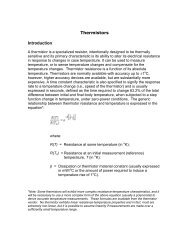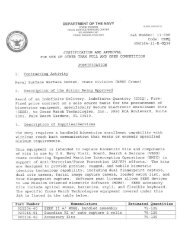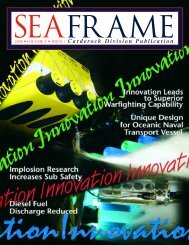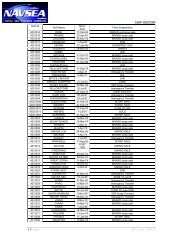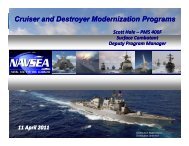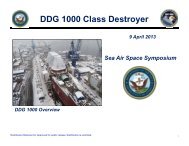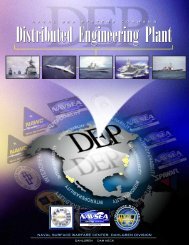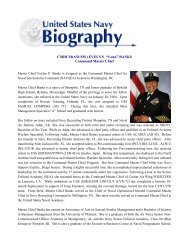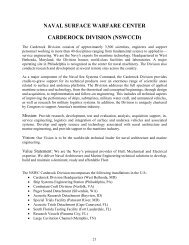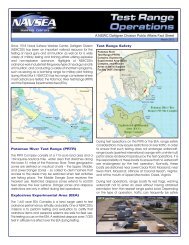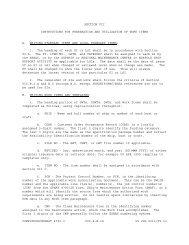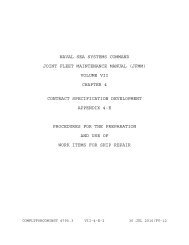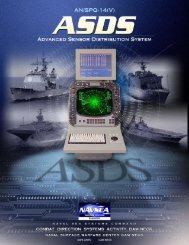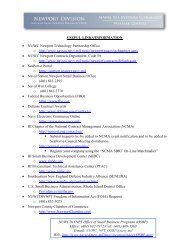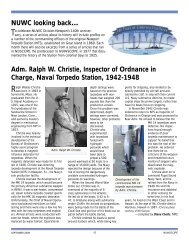Volume 6, Issue 1 - Naval Sea Systems Command - The US Navy
Volume 6, Issue 1 - Naval Sea Systems Command - The US Navy
Volume 6, Issue 1 - Naval Sea Systems Command - The US Navy
You also want an ePaper? Increase the reach of your titles
YUMPU automatically turns print PDFs into web optimized ePapers that Google loves.
SEAFRAME<br />
24<br />
By<br />
Martin<br />
Cohen<br />
Core equities<br />
<strong>The</strong> <strong>Navy</strong>’s Environmental<br />
and Natural Resources Program Manual<br />
requires the fleet to meet a zero plastic<br />
waste discharge requirement (unless ship<br />
safety or the health and safety of the crew<br />
are compromised). A U.S. <strong>Navy</strong> aircraft carrier generates<br />
nearly 1,000 cubic feet (30 cubic yards) of plastic waste per<br />
day. By comparison, smaller ships can generate nearly 50<br />
cubic feet of plastic waste per day. While plastic waste can be<br />
removed from ships during underway replenishments every<br />
three to four weeks, the average aircraft carrier can generate<br />
up to 30,000 cubic feet (1,000 cubic yards) of plastic waste<br />
during that time, and the average surface combatant up to<br />
1,500 cubic feet (more than 50 cubic yards).<br />
Considering that ships cannot discharge plastic<br />
waste overboard, it is easy to see the potential havoc that<br />
this can wreak on operations during a deployment of a U.S.<br />
<strong>Navy</strong> ship. Plastic waste processors (PWPs), also referred to<br />
as compressed melt units (CMUs), were originally designed<br />
and outfitted in the fleet from late 1995 through 1998,<br />
and are used by the fleet to process shipboard generated<br />
plastic waste into dense disks suitable for long-term storage<br />
onboard prior to shore disposal. PWPs reduce the volume of<br />
plastic waste by a 30:1 ratio. <strong>The</strong>se processors allow ships<br />
to retain their plastic waste onboard when at sea and comply<br />
with zero-plastic waste discharge requirements, while<br />
enabling them to operate unrestricted throughout the world.<br />
Fleet operations have shown that the original<br />
design PWPs required excessive man-hours to operate<br />
PLASTIC WASTE<br />
PROCESSOR<br />
Improving the Ability of New Construction<br />
Ships to Process Plastic<br />
and had high corrective and preventative maintenance<br />
costs. Additionally, PWP cleanliness issues related to the<br />
processing of food contaminated plastics have impacted<br />
the fleet. In FY 00, the <strong>Naval</strong> <strong>Sea</strong> <strong>Systems</strong> <strong>Command</strong><br />
(NAVSEA) directed <strong>Naval</strong> Surface Warfare Center,<br />
Carderock Division’s (NSWCCD’s) Environmental Quality<br />
Department to improve the PWP design. <strong>The</strong> initial goals<br />
were to reduce operational and maintenance man-hours<br />
associated with the equipment by 40 percent without<br />
modifying the shipboard interfaces, and enhance the<br />
cleanliness of the equipment.<br />
Assessments were made on the failure rates of all<br />
components, corrosion, and system complexity. High failure<br />
rate components were removed or replaced. Materials<br />
were changed to reduce corrosion issues, and the system<br />
was greatly simplified to enhance reliability, and ease<br />
maintenance and cleaning. Replacement components and<br />
subsystems were designed, fabricated, and then tested for<br />
reliability and ruggedness in the laboratory and in the field.<br />
<strong>The</strong> modified plastics waste processor (MOD I PWP) has<br />
34 percent fewer components and a processing rate 200 to<br />
300 percent greater than the legacy PWP. Also, the electrical<br />
and drive systems were revamped to enhance simplicity and<br />
dependability, and support increased processing rates.<br />
<strong>The</strong> lower frame of the unit was redesigned to<br />
promote ease of cleaning, which is important due to the<br />
processing of food contaminated plastic waste. <strong>The</strong> modified<br />
unit incorporates self-cleaning nozzles that are connected<br />
to the ship’s hot potable water service, greatly reducing



